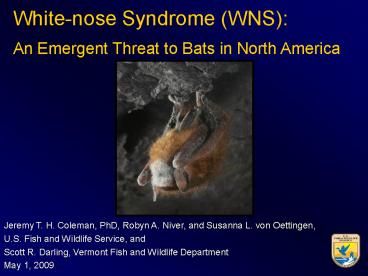Whitenose Syndrome WNS: PowerPoint PPT Presentation
1 / 21
Title: Whitenose Syndrome WNS:
1
White-nose Syndrome (WNS) An Emergent Threat to
Bats in North America
Jeremy T. H. Coleman, PhD, Robyn A. Niver, and
Susanna L. von Oettingen, U.S. Fish and Wildlife
Service, and Scott R. Darling, Vermont Fish and
Wildlife Department May 1, 2009
2
Wildlife Health Crisis
- Over 90 mortality at affected sites
- Spreading rapidly
- All 6 northeastern cave bat species affected
- 1 Federally listed species
3
What is WNS?
- Clinical signs
- A white fungus evident on the nose, ears, or
wings of most affected animals - Wing damage
- Depleted body fat
Jonathan Reichard
4
Behavioral signs
- Abnormal behavior
- Bats flying outside in daylight
- Dead bats near cave entrances or on landscape
5
2007 - 1 state, 4 sites
6
2008 - 4 states, 38 sites
7
2009 9 States, 65 Sites
8
- Why are bats vulnerable?
- Cave hibernators
- Clustering behavior promotes pathogen
transmission - Limited energy resources during hibernation
9
TransmissionBat-to-batLittle brown bat
movement to summer colonies from Mt. Aeolus, VT
hibernaculum
Geographic Spread
Anthropogenic
10
Geographic Spread
- Transmission
- Anthropogenic
- May be spread by human activity
- FWS has requested voluntary ban on caving
11
Williams Preserve, Rosendale, NY
12
Greeley MineStockbridge, VT
13
Old MineChester, MA
14
Aeolus CaveDorset, VTMortality too great to
survey 2008-09
Alan Hicks
Jonathan Reichard
15
Why care about bats?
Bats comprise 1/5 of the worlds mammal
species Bats are the primary night-time predators
of insects
16
Biological Consequences
Bats have extremely low reproductive rates (live
for over 20 years and have only one pup per year)
17
Citizen Concerns
- Reports of bats observed
- Flying during winter days
- Landing on buildings, roofs, windows
- Struggling to fly
- Dying on the ground
18
Lots of Media Interest
- Voice of America
- Canadian Public Radio
- National Public Radio
- Der Spiegel
- Brattleboro Reformer
- Yankee Magazine
- FOX
- Bennington Banner
- Rutland Herald
- Burlington Free Press
- The New York Times
- The Boston Globe
- Los Angeles Times
- Washington Post
- BBC
- CBC
- Vermont Public Radio
- The New Yorker
- National Geographic
- USA Today
- CBS Evening News
19
- 50 partners from Federal and State agencies,
NGOs, and academia working on - Monitoring/Management
- Research
- Outreach
20
Outreach
- www.fws.gov/northeast/white_nose.html
- Media response and public inquiry response
- Video production
- Briefings
- Presentations
- Stakeholder engagement
- WNS display and materials
Radio-Canada-Television. documentary, VT
21
Funded Projects
- Research support
- Immune response
- Investigation of Geomyces fungus
- Hibernation studies
- Population (local and rangewide) level impacts
- Pre-WNS baseline monitoring
- Demographic modeling
- Impacts to bats on summer range
- Contaminants
- Planning efforts
22
Issues
- Investigation takes time
- Complex coordination needs
- Control presents biological and social challenges
- Two listed species vulnerable now
- Potential to impact 25 of 40 N. Am. bat species
23
Concerns

